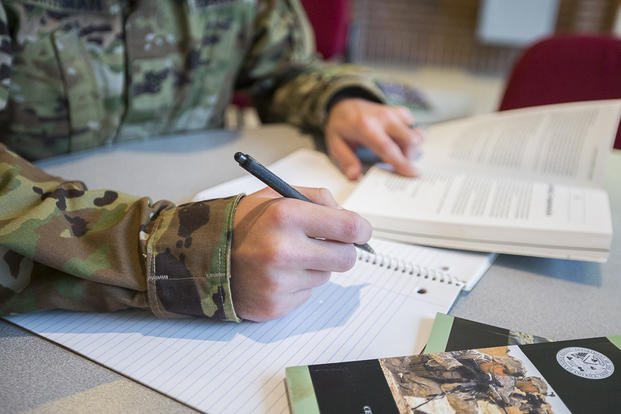The Army is seeking cuts to two major education benefits -- a move that expands previously reported potential cutbacks to credentialing assistance for soldiers and that could affect more than 100,000 troops who tap the benefits each year.
Last week, Military.com reported the Army was eyeing cuts to its Credentialing Assistance program. But the potential upcoming cuts also include its tuition assistance program, the service confirmed to the publication. This is the first time tuition assistance being on the chopping block has been publicly acknowledged.
The education benefits, which are currently under review and cost the Army about $278 million last year, are broadly popular among the rank and file, and are among the service's premier recruiting and retention tools. The Army has historically seen furthering the education of its troops as key to a well-rounded force.
"The Army recognizes the value of both to support our soldiers' professional development and readiness levels," Maj. Andrea Kelly, a service spokesperson, said in a statement to Military.com. "However, in order to ensure their long-term sustainability, the Army is conducting a thorough review of both programs."
The news comes as college degrees and civilian training are becoming more relevant in the service, especially among noncommissioned officers for whom civilian education is quickly becoming expected. The Army is also in the midst of a historic recruiting shortage, and education benefits have long been a critical incentive to fill the ranks.
It's unclear what prompted the benefits review, or whether those funds are even able to be siphoned to other priorities, as law sometimes dictates the services spend money in specific ways. The Army declined interview requests with officials for this story, including with Sergeant Major of the Army Michael Weimer, whose office is traditionally the center of gravity for issues pertaining to the enlisted force, which most often uses the benefits.
Tuition assistance was introduced in 1999, but it was broadly implemented in the Army in 2002 in the wake of the Sept. 11, 2001, attacks when the service needed to quickly beef up its ranks. At the time, college was also becoming a greater priority both in the service and in the civilian workforce.
Since 2020, about 101,000 soldiers across all Army components use the benefit each year -- averaging about $218 million in cost. But it's unclear what specific cuts or changes to tuition assistance the Army is mulling.
The Army's Credentialing Assistance Program, or Army CA, was introduced forcewide in 2020 in its current form, after evolving from a smaller version of the benefit. It was broadly seen by senior leadership as key during a time in which the service wanted troops to have diverse skill sets outside of their military occupation.
At the same time, the Army CA benefit could set soldiers up for success in the civilian world when they transition out of the service.
In the last four years, 64,500 soldiers have used the benefit, with licensing and qualifications in project management, personal training and piloting being among the most frequently chosen fields. The use of the benefit has ballooned since 2020, costing $8 million then and growing to $60.2 million last year, according to data provided by the Army.
Right now, the service is looking to cut its credentialing benefit in 2025 from $4,000 per year without a cap on use to just $1,000 per year and never to exceed $4,000 in a soldier's career, sources with direct knowledge of the deliberations explained to Military.com. The publication also reviewed an internal brief and emails confirming the plans, though it was unclear whether those plans had been finalized.
The cuts would not impact the GI Bill, which is controlled by the Department of Veterans Affairs, or scholarships through the National Guard, which are controlled by the states.
Service-specific education benefits are built for soldiers to use while in service and can be employed piecemeal -- whereas the GI Bill is generally built to be used in semesters, which is often impractical for active-duty troops. The GI Bill is also a benefit that can be transferred to a spouse or child.
Related: Army Eyes Dramatic Cuts to Key Education Benefits for Soldiers












